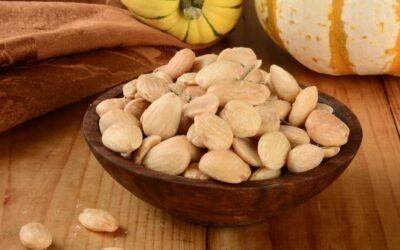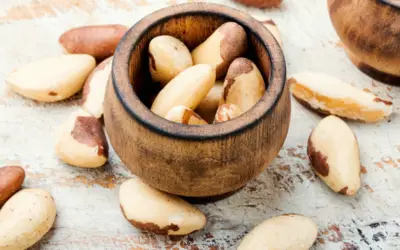
Almond Flour Benefits and Recipes
What is almond flour?
Almond flour is an alternative to wheat flour, for people who want to go gluten free. It can be used to make cakes, pancakes, scones cookies and many more. Because it is rich in proteins, has little carbohydrate content and contains healthy fats, it is a popular option for bakers. In addition, it is relatively easy to make and we have included the recipe for you at the end of the article.
Difference between almond flour and almond meal

You may have come across the term “almond meal” and may have gotten it confused with “almond flour” before. The difference is simple. Almond meal is coarser flour and has a rougher texture, while almond flour is finer. This is because almond flour has its skin removed and appears “cleaner” due to it having been submerged in hot water for a short time to remove its impurities (blanching). Almond meal on the other hand, still has its skin on and that is why the flour is rougher and some brown bits can be seen in the flour. Both, however, are essentially made up of an almond base.
As almond flour has a smoother texture, it is usually used to make macarons and cakes which have a more even surface. Almond meal would be a good choice to make cookies, bread, and cake crumbs which have uneven textures and surfaces.
Benefits of almond flour
Almond flour is rich in vitamin E, which has antioxidant properties that helps to prevent cell damage and promotes heart health, while reducing the risk of developing cancer. Meanwhile, the reason for almond flour being a good substitute for wheat flour is because it is rich in magnesium, which helps people with type 2 diabetes by maintaining their blood sugar levels. Wheat flour on the other hand is high in carbohydrates which can cause fluctuations in sugar levels, meaning that sometimes blood sugar levels can spike and then drop alarmingly. Hence, almond flour is a healthier choice as it is low on the glycemic index and can help people control their blood sugar levels. Furthermore, almond flour is lower in phytic acid (which adheres to minerals such as iron, calcium, and zinc), allowing more nutrients to be absorbed by the intestines. Almond flour may also help to lower “bad” cholesterol levels and lower blood pressure. Most importantly, almond flour is gluten free which means that people with wheat allergies can use almond flour instead.
Uses of almond flour
Now, almond flour can be used in a variety of ways. It can be used for making batter for frying poultry and seafood like shrimps and fish. What you would need to do is to add in an egg to help the flour stick and fry it with a skillet or a sauté pan. Almond flour can also be used as a topping or a garnishing for your pies, baked pastas, and goulash as it would help to add some texture and crunch. Almond flour can also be used in paleo diets, which are diets consisting of whole foods and the avoidance of processed food.
When almond flour is used in baking, it can replace wheat flour in a 1:1 ratio. However, do note that your final product may appear flatter, heavier and damp as it contains more nutrients and oil. Since it lacks gluten, which is a raising agent that enlarges the dough by trapping air, it cannot rise as nicely as dough made with wheat flour. Hence, to tackle this you may use arrowroot flour to provide structure to your bakes. Eggs are also an important ingredient to help provide structure. Coconut flour can be added to remove the moisture and firm up your dough. Try as much as possible to grind the flour as fine as you can, so that it can be raised firmly. You can use almond flour to bake cookies, scones, waffles, muffins, bread, and brownies.
Making Almond flour
Here is a simple way of making almond flour at home.
What you need:
- 1 and a ½ cup of skinless raw almonds (can be sliced or whole)
Equipment:
- A blender
Steps:
- Make sure that the almonds are dry and without moisture. Add the almonds into the blender and turn on the highest speed setting for 5 to 10 seconds.
- Stop the blender and shake off the clumps on the inner walls of the blender.
- Blend them again until it becomes powdery, but not too much such that it forms a liquid or becomes nut butter. In total, you should blend it for up to 15 seconds.
- Ensure that all the almonds have been blended.
- You may keep the flour in a container for up to 1 month (not refrigerated).
Paleo Pancakes Recipe

Here is a delicious breakfast recipe for those that are on a wheat-free diet.
What you need:
- ½ a cup of arrowroot flour
- ½ teaspoon of kosher salt
- 2 large eggs
- ½ teaspoon of baking soda
- 2 tablespoons of honey
- ¼ cup of ghee (separated, melted, and cooled)
- 2 and a ½ cup of almond flour
- 1 large egg white
- 1 teaspoon of pure vanilla extract
- 1 teaspoon of cream of tartar
- 2/3 cup of water
Equipment: Blender, non-stick pan, and oven (to keep warm)
Note: If you want it diary free, you can replace ghee with coconut oil.
Steps:
- Blend the eggs, the egg white, honey, 3 tablespoons of melted ghee, water, and vanilla for 30 seconds until froth appears.
- Pour in arrowroot flour, almond flour, baking soda, salt, and cream of tartar into the blender.
- Put the blender on medium speed and blend for 1 minute, until it is well mixed and even. The mixture should be viscous, but still in liquid state.
- Add 1 teaspoon of ghee onto a 12-inch non-stick pan and set it to medium heat. Heat it until it is glistening.
- Wipe out some of the ghee using a paper towel, but leave a thin film evenly on the pan.
- Pour in the pancake batter, with each pancake’s quantity to be about ¼ cup. You can fill in about three pancakes in one pan.
- Cook one side for about 3-4 minutes, or when it turns golden.
- Flip the pancake and cook the other side until it is golden and for 3-4 minutes.
- You may keep the freshly cooked pancakes warm in an oven set to 93 degrees.
- Repeat the steps with the remaining ghee and pancake batter.
We have raw almonds
If you would like to bake using flour of a healthier option, why not try out almond flour? We have seen that almond flour is gluten-free and is high in vitamin E and magnesium. This helps to maintain one’s blood sugar levels and is beneficial for people with type 2 diabetes. Furthermore, almond flour is easy to make, as seen from our simple recipe and it can be used as batter for meat and as garnishing to create a little texture to your dishes. Check out our raw and roasted almonds here.






